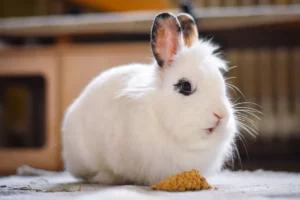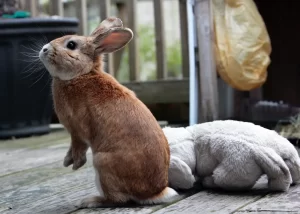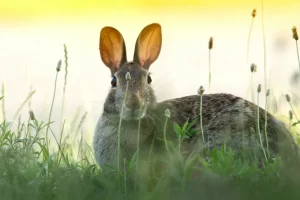Do you ever wonder what wild rabbits do when the winter frost descends?
Like a well-choreographed ballet, these furry creatures take shelter, adapt to the cold, adjust their diet, and navigate social dynamics.
Surviving predators and threats, they brave the harsh winter months with resilience and cunning.
In this article, we will delve into the fascinating world of wild rabbits and uncover the secrets of their winter survival strategies.
Get ready to marvel at their resourcefulness and discover how these adorable creatures serve as nature’s resilient warriors.
In This Article
- 1 Key Takeaways
- 2 Finding Shelter
- 3 Adapting to Cold Temperatures
- 4 Adjusting Diet and Foraging Habits
- 5 Social Behaviors in Winter
- 6 Reproduction and Breeding Patterns
- 7 Surviving Predators and Threats
- 8 Frequently Asked Questions
- 8.1 Are Wild Rabbits More Active During the Day or Night in the Winter?
- 8.2 Do Wild Rabbits Hibernate During the Winter Months?
- 8.3 How Do Wild Rabbits Stay Warm in the Winter Without the Use of External Sources?
- 8.4 Do Wild Rabbits Migrate to Warmer Areas During the Winter?
- 8.5 How Do Wild Rabbits Communicate With Each Other During the Winter Months?
- 9 Conclusion
Key Takeaways
- Wild rabbits rely on winter burrows for shelter, creating intricate tunnel systems for insulation and multiple escape routes.
- They develop a thicker and denser winter coat for insulation and seek shelter in burrows or dense vegetation to protect themselves from the elements.
- Wild rabbits adapt their diet during winter by consuming high-energy foods like nuts and seeds, as well as winter greens and storage crops.
- Social behaviors and grooming are important for wild rabbits during winter, as they form groups called warrens for warmth and protection and engage in grooming to maintain fur and regulate body temperature.
Finding Shelter
You should start looking for a warm and safe place to find shelter during the winter months.
Wild rabbits, like many other animals, have specific hibernation habits and rely on winter burrows to survive the harsh conditions. These burrows serve as a protective shelter, shielding them from the cold temperatures, wind, and predators.
The rabbits carefully select their burrow locations, often digging them in areas with ample vegetation cover or near a reliable food source. They create intricate tunnel systems within the burrows, providing multiple escape routes and additional insulation.
The rabbits line their burrows with grass, leaves, and fur, creating a cozy and comfortable environment. It’s crucial to respect their need for shelter and avoid disturbing or destroying their burrows, as this can have detrimental effects on their survival during the winter months.
Adapting to Cold Temperatures
Bundle up in warm layers and wear a hat and gloves to protect yourself from the cold temperatures, as adapting to frigid weather can be challenging. Just like humans, animals also have their own ways of coping with the winter season. Take wild rabbits, for example. While they may not hibernate like some other animals, they have developed strategies to survive the cold. One of their key adaptations is their winter coat, which becomes thicker and denser to provide insulation against the cold. This allows them to maintain their body temperature and conserve heat. In addition, rabbits will seek shelter in burrows or dense vegetation to further protect themselves from the elements. Overall, these adaptations help wild rabbits thrive in the winter months, ensuring their survival until the arrival of spring.
| Adaptation | Description |
|---|---|
| Winter coat | Thick and dense fur that provides insulation against the cold |
| Seeking shelter | Utilizing burrows or dense vegetation to protect from the elements |
Adjusting Diet and Foraging Habits
Adjust your diet and foraging habits to adapt to the changing availability of food during the winter months. As the temperature drops and snow covers the ground, it becomes more challenging for animals, including humans, to find food. Winter foraging requires a different approach and a keen understanding of the available resources.
Here are some tips to help you make the necessary dietary changes:
- Focus on high-energy foods, such as nuts and seeds, to provide the necessary calories to keep warm.
- Look for winter greens, like wintercress and chickweed, which can provide essential vitamins and minerals.
- Explore the benefits of winter storage crops, such as root vegetables and apples, which can be preserved for longer periods.
- Consider supplementing your diet with high-quality hay or other forage options to ensure a balanced nutrition intake.
Social Behaviors in Winter
Interact with other members of your community to strengthen social bonds and find comfort in companionship during the winter months. While some animals hibernate during this season, wild rabbits remain active and rely on their social behaviors to survive.
Rabbits are social animals and form groups called warrens, where they live together. During winter, these warrens provide warmth and protection against the harsh conditions.
Rabbits also engage in grooming behaviors that help maintain their fur and keep them clean. They use their tongues to groom themselves and each other, removing dirt and parasites. This grooming is essential for their overall health and helps to regulate body temperature.
Reproduction and Breeding Patterns
You can learn about the reproduction and breeding patterns of wild rabbits by observing their mating behaviors and studying the gestation period of their offspring.
Wild rabbits have a breeding season, usually occurring from late winter to early spring. During this time, male rabbits, known as bucks, engage in competitive behaviors to attract females, or does. Mating often involves a brief and intense interaction, with the buck mounting the doe from behind.
After successful mating, the doe will undergo a gestation period of approximately 28 to 31 days. She’ll then give birth to a litter of kits, typically ranging from 4 to 12 babies. To ensure the survival of their offspring, rabbits employ various reproductive strategies, including nesting in concealed burrows and providing milk to nourish the young.
Surviving Predators and Threats
How do wild rabbits protect themselves from predators, and are they able to detect potential threats in their environment?
Wild rabbits have developed several strategies to avoid predators and increase their chances of survival. One important defense mechanism is their ability to detect potential threats in their environment. Rabbits have highly developed senses, particularly their hearing and vision, which allow them to quickly identify predators approaching from a distance. They’re also able to detect the slightest movements and sounds, enabling them to react swiftly and escape from danger.
In addition to their sensory abilities, rabbits also rely on their speed and agility to outrun predators. Their powerful hind legs allow them to make sudden bursts of speed and change direction rapidly, making it difficult for predators to catch them.
These combined strategies of detection, agility, and speed help wild rabbits survive in their natural habitat and avoid becoming prey.
Frequently Asked Questions
Are Wild Rabbits More Active During the Day or Night in the Winter?
During the winter, wild rabbits may exhibit different activity patterns depending on their specific environment and the availability of food and shelter. It is important to consider factors such as temperature, predation risk, and resource availability when studying wild rabbits’ winter habits and behavior.
Do Wild Rabbits Hibernate During the Winter Months?
Wild rabbits do not hibernate during winter months. Instead, they adapt their behavior to survive the cold. They seek shelter in burrows or dense vegetation, rely on stored fat reserves, and reduce activity levels to conserve energy.
How Do Wild Rabbits Stay Warm in the Winter Without the Use of External Sources?
To stay warm in winter, wild rabbits rely on natural insulation provided by their fur. They also increase their food consumption to generate more body heat. These adaptations help them survive the cold without the need for external sources.
Do Wild Rabbits Migrate to Warmer Areas During the Winter?
During winter, wild rabbits don’t migrate to warmer areas. Instead, they rely on their winter adaptations to survive. They have thick fur, stored fat, and dig burrows for shelter. They find food by foraging on available plants and bark.
How Do Wild Rabbits Communicate With Each Other During the Winter Months?
During the winter months, wild rabbits communicate with each other through various methods. They rely on their keen senses of hearing and smell to locate food sources for winter foraging. Socially, they may form larger groups or stay in smaller family units depending on their specific social dynamics.
Conclusion
In conclusion, wild rabbits exhibit remarkable adaptability during the winter season. They seek shelter in burrows and adjust their diet and foraging habits to accommodate scarce resources. They also grow thicker fur to adapt to the cold temperatures. Furthermore, wild rabbits engage in social behaviors to ensure survival and carefully time their reproduction and breeding patterns to maximize chances of offspring survival. Despite facing predators and threats, wild rabbits have evolved effective strategies to thrive in harsh winter conditions.





